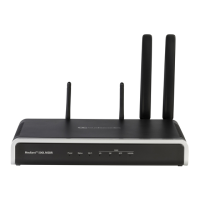User's Manual 67. Configuration Parameters Reference
Version 6.8 871 Mediant 500L MSBR
Parameter Description
> If a channel is released (call ends) during the graceful
period and there are still other busy channels, the device
sends an out-of-service Service message to the idle channel.
> When the last channel is released in the trunk (or Trunk
Group), the device takes all the channels out-of-service
(locks the Trunk Group) without sending an out-of-service
Service message; instead, it only takes the D-channel down.
When connectivity is restored for the Busy Out feature or the
Trunk Group is unlocked, the device brings the D-channel up
again without sending any Service messages to the B-
channels.
- Partially configured trunk (only some channels configured):
The device places all channels out-of-service only after the
graceful period expires, by sending out-of-service Service
messages to the B-channels (the D-channel remains up).
Notes:
When configuring out-of-service behavior per trunk
(DigitalOOSBehaviorForTrunk_x), you must stop the trunk (Stop
Trunk button in the Trunk Settings page), configure the
parameter, and then restart the trunk (Apply Trunk Settings
button in the Trunk Settings page) for the settings to take effect.
To define out-of-service behavior for all trunks (globally), see the
DigitalOOSBehavior parameter.
For locking/unlocking Trunk Groups in the Trunk Group Settings
table, see Configuring Trunk Group Settings on page 375.
For a description of the Busy Out feature and for enabling the
feature, see the EnableBusyOut parameter.
To configure the graceful out-of-service period, see the
GracefulBusyOutTimeout parameter.
If the ISDN variant does not support the configured out-of-service
option of the parameter, the device sets the parameter to Default
[0].
The x in the ini file parameter name denotes the trunk number,
where 0 is Trunk 1.
Web: Digital Out-Of-Service
Behavior
CLI: dig-oos-behavior
[DigitalOOSBehavior]
Defines the method for setting all digital trunks to out-of-service
state. To configure the out-of-service method per trunk, see the
DigitalOOSBehaviorForTrunk_x parameter.
[0] Default = (Default) For a detailed description, see option [0] of
the DigitalOOSBehaviorForTrunk_x parameter (per trunk setting).
[1] Service = Sends an ISDN Service message indicating out-of-
service state (or in-service). For a detailed description, see option
[1] of the DigitalOOSBehaviorForTrunk_x parameter (per trunk
setting).
[2] D-Channel = Takes the D-Channel down or brings it up. For a
detailed description, see option [2] of the
DigitalOOSBehaviorForTrunk_x parameter (per trunk setting).
[3] Alarm = Sends or clears a PSTN Alarm Indication Signal (AIS)
alarm. For a detailed description, see option [3] of the
DigitalOOSBehaviorForTrunk_x parameter (per trunk setting).
[4] Block = Blocks the trunk. For a detailed descript
[4] of the DigitalOOSBehaviorForTrunk_x parameter (per trunk
setting).
[5] Service and D-Channel = Sends ISDN Service messages to
indicate out-of-service or in-service state and takes the D-channel

